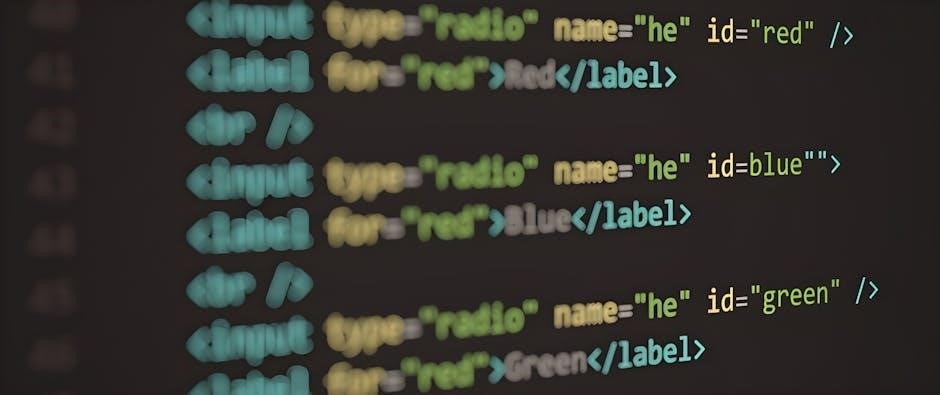full-stack web development with graphql and react pdf download
Explore the powerful combination of GraphQL and React for building modern, scalable web applications. Learn to create efficient APIs and dynamic user interfaces seamlessly.
Why Choose GraphQL and React for Full-Stack Development?
GraphQL and React offer a powerful synergy for modern web development. GraphQL’s flexible query language reduces data fetching issues, while React’s component-based architecture simplifies UI development. Together, they enable efficient, scalable, and real-time applications. React’s hooks enhance state management, complementing GraphQL’s API capabilities. This stack supports seamless integration with tools like Apollo Client, optimizing performance. Developers benefit from reduced boilerplate, better data control, and a robust ecosystem. Whether building enterprise-level or smaller applications, GraphQL and React provide a future-proof foundation for dynamic, user-centric experiences.

Understanding GraphQL Fundamentals
GraphQL is a query language for APIs and a runtime for fulfilling those queries. It allows clients to request specific data, reducing overhead and improving efficiency compared to REST.
What is GraphQL and How Does it Work?
GraphQL is a query language for APIs and a runtime for fulfilling those queries. It allows clients to specify exactly what data they need, reducing overhead. Unlike REST, GraphQL enables flexible queries, mutations, and subscriptions. A GraphQL schema defines types and relationships, while resolvers handle data retrieval. Clients send queries to a server, which processes them and returns precise results. This approach optimizes performance, reduces bandwidth usage, and streamlines API interactions. GraphQL supports real-time updates and caching, making it ideal for modern web and mobile applications. Its versatility and efficiency make it a cornerstone of full-stack development with React.
Advantages of Using GraphQL Over REST
GraphQL offers significant advantages over REST, including reduced bandwidth usage by fetching only necessary data. Its flexible query structure allows clients to request specific fields, eliminating unnecessary data transfer. GraphQL’s ability to handle multiple requests in a single query improves performance. It also supports mutations and subscriptions, enabling real-time updates. Unlike REST, GraphQL provides a schema, making API structure transparent and reducing errors. Its strong typing ensures data consistency and simplifies debugging. Overall, GraphQL enhances scalability, developer productivity, and user experience, making it a superior choice for modern full-stack web development with React.

React Basics for Full-Stack Development
React is a JavaScript library for building dynamic user interfaces. It enables efficient component-based development, promoting reusable code and unidirectional data flow, essential for modern web applications.
React Hooks and Their Role in Modern Development
React Hooks revolutionize how developers manage state and side effects in functional components. Introduced in React 16.8, Hooks simplify component logic by eliminating the need for class components. Popular Hooks like useState handle state, while useEffect manages side effects. They enhance code readability and maintainability, making components more modular and reusable. Hooks enable developers to build dynamic, scalable applications with fewer lines of code. By leveraging Hooks, developers can seamlessly integrate React with GraphQL, creating efficient and modern full-stack web applications. This approach streamlines development, fostering a more intuitive and productive coding experience.

Setting Up the Development Environment
Install Node.js, npm, and essential dependencies to set up your workspace. Configure the project structure for full-stack development, integrating databases and tools for seamless workflow.
Installing Node.js, npm, and Required Dependencies
To begin your full-stack development journey, start by installing Node.js and npm, the package manager for JavaScript. Download the latest version from the official Node.js website and follow the installation instructions for your operating system. Once installed, verify the installation by running node -v and npm -v in your terminal to ensure they are correctly set up.
Next, create a new project directory and navigate to it in your terminal. Initialize the project using npm init to generate a package.json file. Install essential dependencies like express for the backend, react, and apollo-client for the frontend. Use npm install to add these packages to your project, ensuring you have the necessary tools for both GraphQL and React development.
Configuring the Project Structure for Full-Stack Development
A well-organized project structure is essential for efficient full-stack development. Create separate directories for the frontend (React) and backend (Node.js) to maintain clarity. Install React using create-react-app for the frontend, and set up an Express server for the backend. Ensure both directories have their own package.json files to manage dependencies independently.
Install apollo-client and graphql for integrating GraphQL with React. Organize your backend with folders for schemas, resolvers, and models. This structure ensures a clean separation of concerns and simplifies scalability as your project grows.
Integrating Databases with GraphQL and React
Integrate databases seamlessly with GraphQL and React using libraries like Prisma or TypeORM. Prisma provides a powerful ORM for TypeScript, enabling efficient database operations. Use Apollo Client to fetch data from your GraphQL server and update React components. Set up resolvers on the backend to interact with your database, ensuring queries and mutations are handled correctly. Proper database integration ensures your full-stack application is scalable and performs efficiently. Follow best practices for structuring your database schema and resolvers to maintain a clean and scalable architecture.

Building the Frontend with React and GraphQL
Use React components to craft dynamic and responsive UIs. Leverage Apollo Client for seamless GraphQL data fetching and state management. Build scalable and efficient frontend applications with ease.
Creating React Components for Dynamic UI
Learn to build reusable and modular React components that drive dynamic user interfaces. Use functional components and hooks like useState and useEffect to manage state and side effects. Implement responsive designs that adapt to user interactions. Discover how to fetch data from GraphQL APIs using Apollo Client and display it seamlessly in your components. Explore best practices for structuring components, optimizing performance, and ensuring scalability. By mastering React components, you can create engaging and efficient frontend experiences that integrate perfectly with your GraphQL backend.
Integrating Apollo Client with React for GraphQL Queries
Seamlessly integrate Apollo Client with React to fetch and manage data from GraphQL APIs. Set up Apollo Client in your React app to handle queries, mutations, and subscriptions. Use the useQuery hook to fetch data asynchronously and update your components automatically. Implement caching strategies to optimize performance and reduce server load. Leverage Apollo’s built-in features like pagination and refetching to enhance data handling. By combining React’s component-based architecture with Apollo’s robust data management, you can build efficient and scalable frontend applications that interact smoothly with your GraphQL backend.
Using React Hooks to Manage State and Side Effects
React Hooks revolutionize state management and side effects in functional components. Use useState to manage local state, useEffect for handling side effects like API calls, and useContext for global state. Hooks simplify code, eliminating class components and enhancing readability. They enable efficient management of component lifecycle and state changes, making it easier to build reusable and maintainable code; By leveraging Hooks, developers can create dynamic, interactive applications with fewer lines of code, ensuring better performance and scalability in full-stack web development with GraphQL and React.

Setting Up the Backend with Node.js and Express
Install Node.js and npm, then set up Express to create a robust backend framework. Configure the project structure for seamless integration with your frontend and database.
Creating a GraphQL Server with Node.js and Express
To set up a GraphQL server, install Node.js and Express, then create a basic server structure. Use middleware to handle requests and define your GraphQL schema with types and resolvers. Implement queries, mutations, and subscriptions to manage data flow. Integrate Apollo Server for enhanced functionality and scalability. Ensure proper error handling and logging for robust backend development. This setup provides a solid foundation for building a full-stack application with React and GraphQL.
Defining GraphQL Schemas and Resolvers
A GraphQL schema defines the structure of your data and operations. It specifies types, queries, mutations, and subscriptions. Resolvers are functions that execute these operations, fetching or modifying data. Start by creating a basic schema with essential types, then implement resolvers to handle requests. Use modularization for scalability. Resolvers can interact with databases or APIs, ensuring data is fetched or updated correctly. Best practices include error handling and validation. Tools like Apollo Server simplify schema definition and resolver implementation, enabling efficient and maintainable backend development for full-stack applications.
Implementing Authentication and Authorization
Authentication and authorization are critical for securing full-stack applications. Implement JSON Web Tokens (JWT) to verify user identities and manage sessions; Use libraries like Express-JWT for backend integration; Define permission levels using role-based access control (RBAC) to restrict or grant access to resources. Authenticate users by verifying credentials against a database, then issue tokens for validated requests. In GraphQL, enforce authorization by checking permissions in resolvers. Use middleware to validate tokens before processing requests. Best practices include input validation, rate limiting, and secure token storage. Integrate authentication with React using context or Apollo Client for a seamless user experience.

Integrating React and GraphQL for a Seamless User Experience
Integrate React with GraphQL using Apollo Client for efficient data management. Leverage React Hooks to optimize state handling and enhance user experience dynamically and efficiently.
Optimizing Data Fetching with Apollo Client
Apollo Client simplifies and optimizes data fetching in React applications by providing a robust caching mechanism. It reduces redundant queries by storing fetched data locally, improving performance. With features like pagination and caching strategies, developers can efficiently manage data retrieval. Apollo Client also supports real-time updates through subscriptions, ensuring a seamless user experience. By leveraging these tools, you can build scalable and efficient applications, enhancing both frontend performance and backend integration. This approach ensures optimal data handling, making your React and GraphQL applications faster and more responsive.
Handling Mutations and Subscriptions in React
Mutations and subscriptions are essential for real-time interaction in React applications using GraphQL. Apollo Client provides hooks like `useMutation` and `useSubscription` to handle these operations seamlessly. Mutations allow users to modify data, while subscriptions enable real-time updates, enhancing user experience. By integrating these features, developers can create dynamic, interactive applications. Apollo Client’s caching and re-rendering capabilities ensure efficient data handling. This approach streamlines communication between frontend and backend, making it ideal for building responsive and scalable full-stack applications with React and GraphQL.

Best Practices for Error Handling in GraphQL and React
Effective error handling is crucial for robust full-stack applications. Use Apollo Client’s error handling features to manage GraphQL errors in React, ensuring user feedback and smooth recovery. Implement error boundaries to catch and display errors gracefully. Validate inputs on both client and server sides to prevent invalid data. Use GraphQL’s error types and resolvers to provide detailed error messages. Log errors for debugging and monitoring. Employ optimistic updates with rollback capabilities to handle mutations. Follow these practices to enhance user experience, maintain application stability, and simplify debugging in your React and GraphQL projects.

Advanced Topics in Full-Stack Development
Dive into advanced topics like performance optimization, security best practices, and scalable deployment strategies for GraphQL and React applications, ensuring your full-stack projects are production-ready and efficient.
Implementing Pagination and Caching in GraphQL
Optimize your GraphQL applications with pagination and caching to enhance performance; Pagination allows fetching specific data segments, reducing payload size and improving load times. Caching stores frequently accessed data, minimizing server queries and speeding up responses. Implement cursor-based pagination for infinite scrolling or offset-based for numbered pages. Use Apollo Client for client-side caching and Redis for server-side caching. Both strategies ensure efficient data retrieval and reduce server load. By combining these techniques, you can build scalable and responsive full-stack applications, delivering a seamless user experience while maintaining optimal performance.
Using WebSockets for Real-Time Updates in React
WebSockets enable real-time communication between the client and server, allowing instant updates without page refreshes. In React, integrate WebSockets with libraries like Socket.IO or the native WebSocket API to create interactive experiences. This is ideal for applications like chat apps, live dashboards, or collaborative tools. WebSockets maintain a persistent connection, reducing latency and enabling bidirectional data flow. Combine this with React’s state management to dynamically update components as data changes. This approach enhances user engagement and provides a seamless, responsive experience. Implementing WebSockets alongside GraphQL and React ensures efficient real-time communication in modern web applications.
Deploying the Application on AWS or Other Cloud Platforms
Deploying your full-stack application on AWS or other cloud platforms enhances scalability and reliability. Start by hosting your React frontend on AWS S3 or Vercel for static sites. For the backend, use AWS Lambda or Heroku to run your Node.js server. Consider AWS Amplify for a streamlined experience with GraphQL and React. Ensure database integration with services like Amazon DynamoDB. Implement CI/CD pipelines using AWS CodePipeline or Heroku’s GitHub integration. Secure your application with AWS Cognito for authentication and manage domains and SSL with AWS Route 53 or Vercel. Monitor performance with AWS CloudWatch or Heroku’s logging tools. Choose the platform that balances ease of use, cost, and scalability for your needs.

Downloading and Using the Full-Stack Web Development PDF Guide
Download the comprehensive PDF guide to master full-stack development with GraphQL and React. Learn modern APIs, deployment on AWS, Heroku, or Vercel, and optimize your workflow with practical examples and best practices for a seamless learning experience.
Top Resources for Full-Stack Web Development with GraphQL and React
Discover the best resources for mastering full-stack web development with GraphQL and React. Explore books like “Hands-On Full-Stack Web Development with GraphQL and React” by Sebastian Grebe, which offers practical guidance. Online courses on Udemy, Coursera, and FreeCodeCamp provide interactive learning. The official React and GraphQL documentation are invaluable for deep understanding. Additionally, community-driven platforms like GitHub and Stack Overflow offer extensive tutorials and forums. Leverage these resources to build scalable applications with modern APIs, optimize data fetching, and deploy seamlessly on cloud platforms like AWS or Heroku.
Recommended Books and eBooks for In-Depth Learning
Enhance your skills with books like “Hands-On Full-Stack Web Development with GraphQL and React” by Sebastian Grebe, offering practical, project-based learning. Explore “Full-Stack GraphQL Applications” to master the GRANDstack (GraphQL, React, Apollo, and Neo4j). For a comprehensive guide, “React and GraphQL: The Complete Guide” provides detailed insights into building modern web applications. These resources cover everything from setting up development environments to deploying scalable applications. Download these eBooks to gain hands-on experience and deepen your understanding of full-stack development with GraphQL and React.
Free and Paid Courses to Master Full-Stack Development
Enroll in courses like “Full-Stack Web Development with GraphQL and React” on Udemy or Coursera to master modern web development. Platforms like freeCodeCamp and Codecademy offer free courses to learn React and GraphQL fundamentals. For advanced learning, explore “Learning Full-Stack JavaScript Development” covering MongoDB, Node.js, and React. Paid courses like “MERN STACK BOOTCAMP” provide hands-on training in MongoDB, Express, React, and Node.js. These resources offer structured learning paths, practical projects, and expert guidance to help you build scalable, production-ready applications. Start your journey to becoming a proficient full-stack developer with these comprehensive courses.